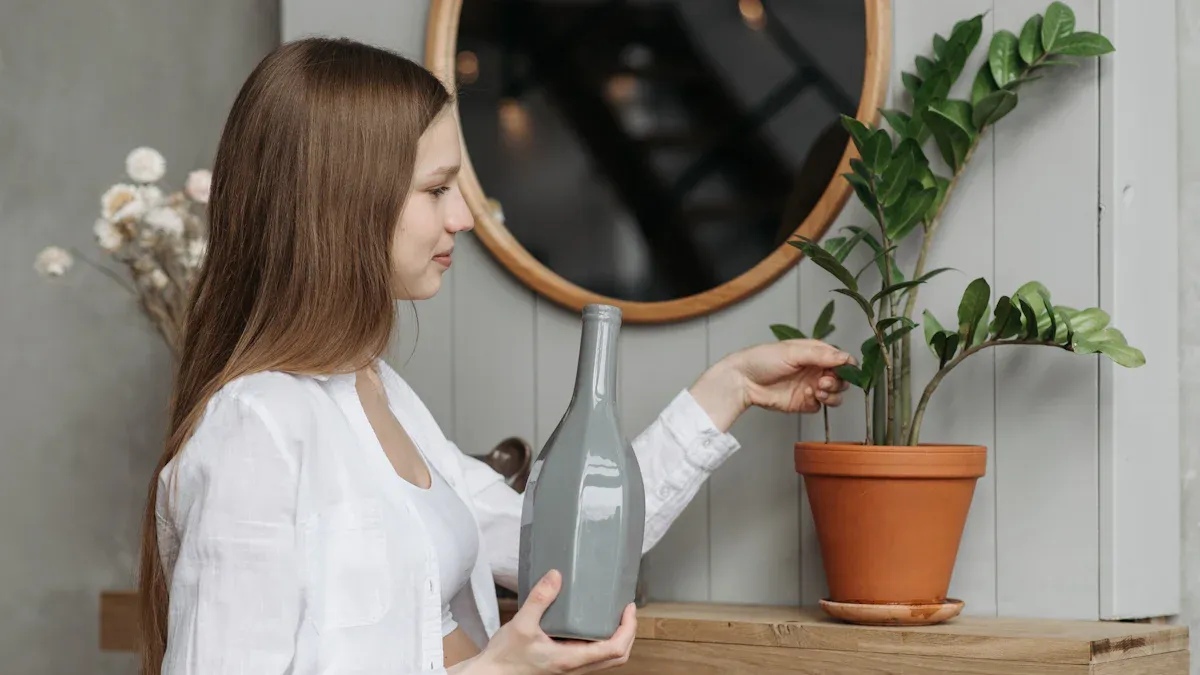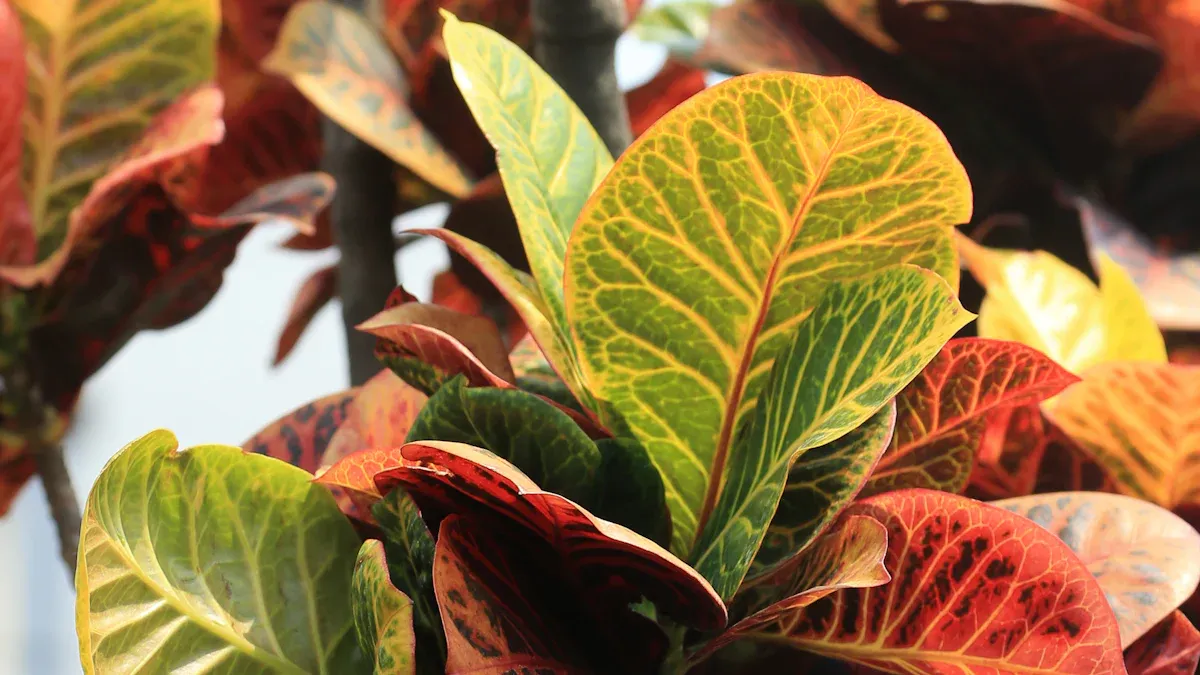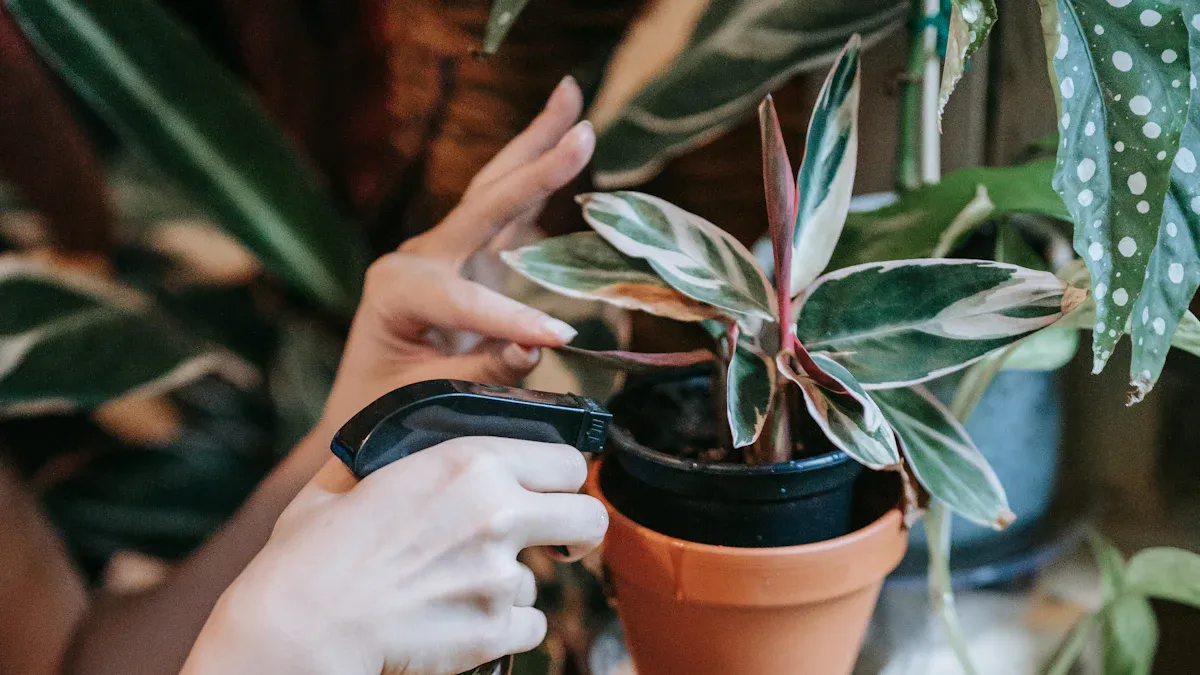
Have you ever looked at your Codiaeum plant and thought, “What happened to you?” The vibrant leaves that once thrived may now appear dull and lifeless. Recognizing these signs early is crucial. If you spot yellowing leaves or drooping stems, it’s time to act! Remember, with the right houseplant care, you can save a dying Codiaeum plant and bring it back to life. Your efforts can make all the difference!
Key Takeaways
Identify symptoms early. Look for yellowing leaves or drooping stems to catch problems before they worsen.
Adjust your watering habits. Check soil moisture before watering to prevent overwatering and root rot.
Boost humidity levels. Use a humidifier or group plants together to create a more humid environment for your Codiaeum.
Treat pests promptly. Regularly inspect your plant and use appropriate treatments to keep it healthy.
Fertilize correctly. Use balanced fertilizers during the growing season to support your plant’s recovery and growth.
Symptoms of Decline

Yellowing Leaves
When you notice your Codiaeum’s leaves turning yellow, it’s often one of the first symptoms of trouble. This change can signal various issues, such as overwatering or nutrient deficiencies. If you see yellow leaves, take a moment to check your watering habits. Are you giving your plant too much water? Or perhaps it’s not getting enough nutrients? Here are some common causes of yellowing leaves:
Overwatering
Nutrient deficiency
Poor drainage
Wilting or Drooping
Wilting or drooping leaves can be alarming. You might feel like your plant is begging for help! This symptom often indicates water stress. It can happen due to either overwatering or underwatering. To help you understand better, here’s a quick table of environmental factors that contribute to wilting:
Environmental Factor | Description |
|---|---|
Water Stress | Wilting leaves often indicate water stress due to over or underwatering, leading to symptoms like drooping leaves and dry soil. |
Heat Stress | Prolonged exposure to direct sunlight or high temperatures can cause wilting, with signs such as yellowing leaves and crispy edges. |
Leaf Drop
If you start seeing dropping leaves, it’s a significant indicator that your Codiaeum is in distress. Leaf drop can occur for several reasons, including stress from environmental changes or improper care. Here are some common reasons for leaf drop:
Sudden temperature changes
Overwatering
Low humidity
You might also notice brown tips or edges on the leaves. These can suggest underwatering or low humidity levels. Keeping an eye on these symptoms can help you act quickly and save your plant.
Causes of Decline
Overwatering
Overwatering is one of the most common issues you might face with your Codiaeum plant. When you give your plant too much water, it can lead to serious problems. The roots may become waterlogged, which prevents them from getting the oxygen they need. This can cause yellowing leaves, a clear sign that your plant is struggling. Here are some signs of overwatering to watch for:
Yellowing leaves
Root rot
Moldy soil
To avoid overwatering, always check the soil moisture before watering. Stick your finger about an inch into the soil. If it feels damp, hold off on watering for a few days. This simple practice can help maintain healthy root health and prevent decline.
Lack of Humidity
Codiaeum plants thrive in high humidity, ideally between 50-70%. When the air is too dry, your plant can suffer from excessive water loss through transpiration. This can lead to wilting and leaf drop. Low humidity can also increase the risk of pests, which can further stress your plant. If you notice your Codiaeum looking droopy or its leaves curling, it might be time to boost the humidity around it. Here are some tips to increase humidity:
Use a humidifier in the room.
Group your plants together to create a microclimate.
Place a tray of water with pebbles under the pot.
By maintaining proper humidity levels, you can help your Codiaeum flourish.
Insufficient Light
Insufficient light is another factor that can lead to the decline of your Codiaeum plant. If your plant isn’t getting enough light, it may exhibit leggy growth and pale foliage. These symptoms indicate that your plant is stressed and struggling to thrive. To ensure your Codiaeum gets the light it needs, consider the following:
Place it in bright, indirect sunlight.
Adjust its position seasonally for optimal light exposure.
Use grow lights if natural light is limited.
Codiaeum plants, especially varieties like the ‘Sunny Star Croton’, thrive in light levels between 1,000 to 2,000 lux. Keeping your plant in the right light conditions can significantly improve its health.
Pest Infestation
Pests can wreak havoc on your Codiaeum plant. Common pests include mealybugs, red spider mites, and thrips. These pests drain sap from the leaves, leading to lesions and potential plant decline. If you notice small webs or brown streaks on your plant, it’s time to take action. Here’s how to deal with pests:
Inspect your plant regularly for signs of infestation.
Use insecticidal soap or neem oil to treat affected areas.
Keep your plant clean by wiping down the leaves with a damp cloth.
By staying vigilant and treating pest issues promptly, you can help your Codiaeum recover and thrive.
Save a Dying Codiaeum Plant

Adjust Watering Practices
To save a dying Codiaeum plant, start by adjusting your watering practices. Overwatering is a common mistake, so you need to be careful. Here’s a simple table to help you understand effective watering methods:
Method | Description |
|---|---|
Check watering habits | Water based on soil dryness. |
Boost humidity | Increase humidity if leaf tips are brown or crispy. |
Ensure proper drainage | Reduce watering and ensure proper drainage to prevent overwatering. |
You should aim to water your Codiaeum thoroughly but infrequently. Avoid giving too much water at once. Instead, check the soil moisture by inserting your finger into the potting soil a few times a week. If it feels too moist, hold off on watering. This practice helps prevent root rot and keeps your plant healthy.
Optimize Humidity Levels
Codiaeum plants love humidity! To create a thriving environment, you need to optimize humidity levels around your plant. Here are some effective techniques:
Technique | Description |
|---|---|
Use a humidifier | Humidifiers effectively increase humidity levels in the home, especially during winter months. |
Group plants together | Grouping plants can create a more humid microenvironment, benefiting humidity-loving species. |
Use pebble trays | Pebble trays allow water to evaporate around the plant, boosting humidity without waterlogging roots. |
Mist plants | Misting leaves with water increases moisture in the surrounding air, though frequent misting may be needed. |
Place plants in bathrooms | Bathrooms often have higher humidity due to showers, making them ideal for humidity-loving plants. |
By using these techniques, you can significantly improve the humidity around your Codiaeum. Remember, higher humidity levels help your plant thrive and prevent issues like leaf drop.
Treating Pests
If you notice pests on your Codiaeum, it’s time to act quickly. Common pests like spider mites and mealybugs can cause serious damage. Here’s a table of treatments you can use:
Pest Type | Chemical Treatment | Organic Treatment |
|---|---|---|
Spider Mites | Miticides or insecticidal soap | Neem oil, increase humidity |
Scale Insects | Systemic insecticides | Rubbing alcohol on a cotton swab |
Mealybugs | Insecticidal soap or systemic insecticides | Neem oil, introduce natural predators |
Regularly inspect your plant for signs of infestation. If you spot any pests, treat them promptly with the appropriate method. Keeping your plant clean by wiping down the leaves can also help prevent pest problems.
Fertilizing Correctly
Fertilizing your Codiaeum plant correctly is crucial for its recovery. Here are some tips to keep in mind:
Use fertilizers with ideal NPK ratios like 3-1-2 or 8-2-10. These ratios emphasize high nitrogen for foliage and potassium for vigor.
Organic fertilizers, such as those derived from fish meal or kelp, are great for sustainable care. Synthetic options like Miracle-Gro can provide quick results for ailing plants.
Fertilize during the growing season with a diluted, balanced fertilizer once a month. This helps your plant regain strength and encourages new growth.
Improper fertilization can lead to impaired growth and increased susceptibility to pests. So, make sure you’re feeding your Codiaeum the right nutrients to help it bounce back.
By following these steps, you can save a dying Codiaeum plant and restore its vibrant health. Remember, patience and consistent care are key!
Identifying symptoms and causes is your first step toward saving your Codiaeum plant. By recognizing issues like yellowing leaves or wilting, you can take action before it’s too late.
Remember, consistent care is vital! Here are some key points to keep in mind:
Croton plants thrive with proper light, humidity, and temperature.
They can live for decades with the right attention.
Be patient as you implement these solutions. With time and care, your Codiaeum can bounce back and flourish once again! 🌱
FAQ
What should I do if my Codiaeum leaves are turning brown?
Brown leaves often indicate underwatering or low humidity. Check the soil moisture and increase humidity around your plant. Misting or using a pebble tray can help boost moisture levels.
How often should I water my Codiaeum plant?
Water your Codiaeum when the top inch of soil feels dry. This usually means watering every 1-2 weeks, depending on your environment. Always ensure proper drainage to prevent root rot.
Can I revive a Codiaeum with root rot?
Yes, you can revive a Codiaeum with root rot. Trim away the affected roots and repot the plant in fresh, well-draining soil. Adjust your watering habits to prevent future issues.
How can I tell if my Codiaeum is getting enough light?
If your Codiaeum has leggy growth or pale leaves, it may not be getting enough light. Move it to a spot with bright, indirect sunlight to encourage healthy growth.
What pests should I watch for on my Codiaeum?
Common pests include spider mites, mealybugs, and aphids. Regularly inspect your plant for signs of infestation, like webbing or sticky residue. Treat any pests promptly to keep your plant healthy.

